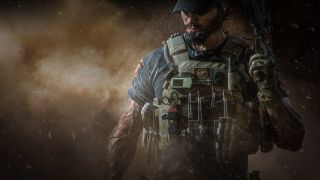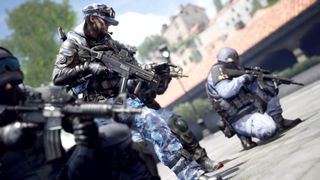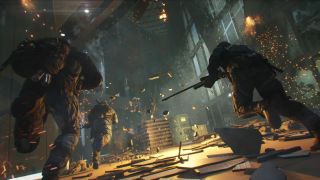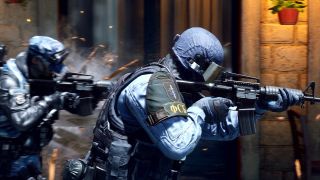

Game CrossfireX
Developer Smilegate
Publisher Xbox Game Studios
Platforms PC, Xbox One, Xbox Series X
Release 2020
CrossfireX is an FPS that has been displaced from its time. It harkens back to an era of competitive shooter where the rules of engagement couldn't be easier to understand: point, click, pray. You may also know this style of play by its more conventional branding, that of the Counter-Strike 1.6 contender. Split-second decisions are all that stand between victory and defeat, with combat contained to close-quarters engagements across a handful of tightly constructed arenas.
CrossfireX lands in a world where Counter-Strike: Global Offensive remains a domineering force for those in the market for a decidedly old-school team-based shooter. For those with a penchant for competitive action and a lowered skill ceiling, the hero shooter pioneered by Team Fortress 2 and perfected in Overwatch remains as popular as ever. In recent weeks, Valorant arrived with the intent to bring these two styles of play together and has found great success in doing so. Heading into a hands-on session for CrossfireX – ahead of its open beta for Xbox One on June 25 – I hoped to get a better sense of who exactly this game is for.
After a couple of hours with CrossfireX, I can't say that I'm all that certain.
Embracing the old-school

Developer Smilegate is intent on bringing Crossfire to western markets in a big way. Not to get trapped in a history lesson here, but the series launched back in 2007 and quickly went on to earn the title of the most-played online FPS in the world. It's huge in Asia and South Korea, boasting a lifetime total of one billion players in 80 countries worldwide. Crossfire was a heavily localised and well-optimised PC game that could run on a huge number of systems – its focus on fast first-person shooting from the hip certainly didn't hurt either. But still the eyes of the western world fell to Valve's competitive shooters.
And so Smilegate is making its play for the west with CrossfireX in 2020. What Xbox One users are getting, then, is a free-to-play shooter that strips the complexity out of PC-based team-based shooters and pairs it up with competent gunplay. It's Classic Mode where CrossfireX is largely going to win players over, or lose them entirely. It's a purely instinctual affair. There's no sprinting and no aiming-down sights; if you spot an enemy, you plant your feet, shoot from the hip, and hope you pulled the trigger first. There's an objective to complete, too; plant the bomb at one of two demolition points, with teams split between attacking and defending. So far, so Counter-Strike.
CrossfireX does, however, make some smart tweaks to conventional genre tropes that appealed to the competitive portion of my brain that's been eroded by years of casual Call of Duty. There's no in-match economy to worry about, for example, which means you're able to cycle through loadouts freely at the beginning of each round without worrying about how much money you've got in the bank.

"I didn't get a clear sense of why CrossfireX should divert my time away from other FPS games."
I'm sure many PC players would balk at the idea of this, but it has the capacity to create a different type of meta. It means you are able to assess threats on the opposing team as games push on and adjust accordingly, without the pressure of investing in something like a sniper rifle or shotgun only to lose it immediately because you put a hit-frame out of place. I can see this making the competitive shooter a little more palatable for western players, particularly those that have only ever played console shooters and heard of classic Counter-Strike from afar.
Sign up to the GamesRadar+ Newsletter
Weekly digests, tales from the communities you love, and more
What will be less palatable for all is the core play itself. If you've spent years only playing a certain breed of modern shooters, then there's a good chance that you're going to either fall in love with, or immediately bounce off of, CrossfireX. It feels solid but unspectacular – world's apart from Call of Duty: Modern Warfare, Rainbow Six: Siege, and Overwatch. Oh, and a little tip before you dive into the beta to try the game out for yourself: get into the menus and mess around with the settings. It takes a little tweaking to get the sensitivity of the sticks even close to right, with slight adjustments either way making it feel as if I were either trudging through mud or gliding on ice.
But there were moments that CrossfireX all kicked into place. The power of these competitive shooters lies in their ability to make you feel like a dominant force. When you get the feeling for a particular weapon and its recoil pattern, for enemy-player attack routines and favoured positioning, it isn't long before you can feel like a true terror – as empowering of a feeling in multiplayer games as you could hope to find. CrossfireX delivered these moments, but they were far and few between in the games I played.
Concessions to modern shooters

CrossfireX also comes equipped with a Modern mode, which is a far more traditional affair albeit with a few fun twists. Here, teams fight for territorial control over two objective points with access to conventional FPS systems – the ability to sprint, quickly respawn, and aim-down-sights. CrossfireX is capable at this increased speed, offering a familiar experience that should appeal to those kept at arms length by the somewhat ruthless nature of the Classic mode.
That fun twist I mentioned sees an element of progression introduced to play, both in terms of your loadout and the map itself. Score enough points and you'll be able to imbue your soldier with a perk of sorts, such as the ability to move a little faster around the map or equip a specialised loadout that comes with a shield and automatic pistol – it's a fun way of spicing up engagements that can otherwise feel a little rote as round-time winds on.
Better still, however, is the shift in the structure of the battlefield; when a team collects enough points the skyscraper you're in begins to collapse, giving you a minute to zipline down to the surrounding area and fight for control of a single objective location.


Modern is a fun shift from the conventional play of Crossfire, but it's offering little new if you've played a multiplayer shooter in the last decade. That's largely my issue with CrossfireX, I didn't get a clear sense of why I should divert my time away from other FPS games.
It's certainly great to see a very traditional, very competitive shooter arrive in a time where the battle royale is dominant – there's something about the intimate nature of this style of game that's lost in the fray of Apex Legends and Call of Duty: Warzone. But it doesn't appear to bring all that much that's new or particularly exciting to the table either, more of a Warface than a Rainbow Six Siege, if you catch my drift.
Still, it's early days. Free-to-play shooters should be given some allowance of time to settle into a rhythm and routine, to better bend to serve the community that will inevitably form around it. I can see myself checking back in with CrossfireX throughout the beta to see if my lukewarm reaction heats up.
And I'll definitely return for the full release later in the year to play the campaign, developed by Control and Max Payne's Remedy Entertainment, as the underlying systems and mechanics are stable. But, as it stands, Smilegate appears to be offering a solid, but otherwise unspectacular, old-school first-person shooter at a time where the genre feels like it is in the midst of a long-overdue evolution.
For more on GamesRadar+, check out the biggest upcoming games of 2020 still on the way, or watch our latest episode of Trending Topics below.

Josh West is the Editor-in-Chief of GamesRadar+. He has over 15 years experience in online and print journalism, and holds a BA (Hons) in Journalism and Feature Writing. Prior to starting his current position, Josh has served as GR+'s Features Editor and Deputy Editor of games™ magazine, and has freelanced for numerous publications including 3D Artist, Edge magazine, iCreate, Metal Hammer, Play, Retro Gamer, and SFX. Additionally, he has appeared on the BBC and ITV to provide expert comment, written for Scholastic books, edited a book for Hachette, and worked as the Assistant Producer of the Future Games Show. In his spare time, Josh likes to play bass guitar and video games. Years ago, he was in a few movies and TV shows that you've definitely seen but will never be able to spot him in.
Most Popular
